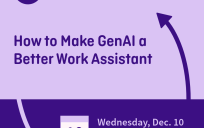State and local government employees are on the ground floor of public service. They‘re the ones who are constantly engaging with the community, whether it’s about the schools their citizens attend, trash collection or building permits. In short, city and state employees are the ones that make it happen.
And just like their federal counterparts, state and local govies are feeling the fiscal pinch. They have less resources on hand, and yet they are being asked to do so much more, including building digital services, protecting critical data and improving infrastructure.
It’s a lot to juggle. And it’s certainly challenging. So what are state and local governments most worried about? In this week’s DorebekINSIDER Live, we sat down with a panel of experts to address the top challenges facing state and local governments and how they are innovating despite tight resources. The speakers included:
- Kelly Rickert, Director of Workforce Innovations at Maine’s Office of Information Technology
- Brent Nair, Director and Chief Information Officer for the city of Memphis
- Daniel Hanttula, Vice Chancellor of Innovation for Oklahoma’s Office of Management and Enterprise Services – Information Services Division
Hanttula kicked it off by discussing the innovation challenges that the state of Oklahoma faces. Within the Office of Management and Enterprise Services (OMES), the goal is to partner with the state agencies and affiliates to deliver quality, cost effective and secure information technology services. “With no money, time or love, it becomes challenging to launch innovative ventures at the state level,” Hanttula said.
Many times, a lot of energy is put into launching projects, where they eventually fizzle out. Oklahoma faced both internal and external challenges, including a zero-dollar threshold for IT spending and lack of incremental funding. In terms of the zero-dollar threshold, every dollar spent on technology must first go through OMES for review.
Externally, there was a lack of public reception for any type of innovative changes and challenges keeping up with the burgeoning tech community.
Hanttula described Oklahoma’s launching of a portal that will serve as a hub for collaboration between the state government and its citizens. “From a government perspective, it’s always good to put customers first,” he said. The goal of OMES is to drive business innovation through technology and promote collaboration across state entities.
It will also be important to use all government resources effectively and efficiently. Through innovation, OMES hopes to engage customers, empower employees and optimize operations. For projects to get off the ground successfully, Hanttula introduced the Idea Management Process, which requires state governments to be clear to constituents, fair to the development community, and to involve agencies they hope to serve. Citizen involvement is important, where the idea of teaching them “assertive complaining” leads to agencies getting proper feedback from constituents.
Another challenge local governments face is implementing technology to benefit cities. Nair described the growth of “smart cities,” which are doing just that. He noted examples of how Memphis uses technology to improve the lives of its citizens. From creating apps for people to map out their commute to offering free Wi-Fi and better traffic analysis, Memphis is working to improve and reimagine the city. Memphis reduced IT service requests by half in one year by using pre-existing technology and embracing collaboration and creativity to prompt progress.
When it comes to facing these challenges, Nair pointed toward three core values: innovation, customer service and collaboration. “We want to create a culture of change,” he said.
Finally, Maine’s Rickert discussed the challenge of recruiting. Several problems with the current workforce included getting new talent with the proper skills and developing and training the existing workforce to become mentors.
For many state and local governments, automating processes and going paperless promotes efficiency in operations, especially in partnership with HR. In order to recruit quality IT talent, the state’s Office of Information Technology tripled its applicant pool after challenging interns to present directly to the governor. Through this pilot study, they found better, more quality candidates in a faster amount of time thanks to the new automated process.
“Social media plays a big part,” Rickert said. Much of recruiting required partnering with HR to foster career fairs and promote outreach into the local community. The study also brought forward an intern program with greater diversity that catered to non-traditional interns, such as veterans, adult learners and non-academic technical students. Rickert also highlighted mentorship programs and the importance of feedback to strengthen the workforce.
There will be quite a few challenges to face in the future, including cybersecurity, more streamlined processes, diversification of workforce and digitization. However, state and local governments are stepping up to meet these challenges and create better lives for their citizens going forward.






Leave a Reply
You must be logged in to post a comment.